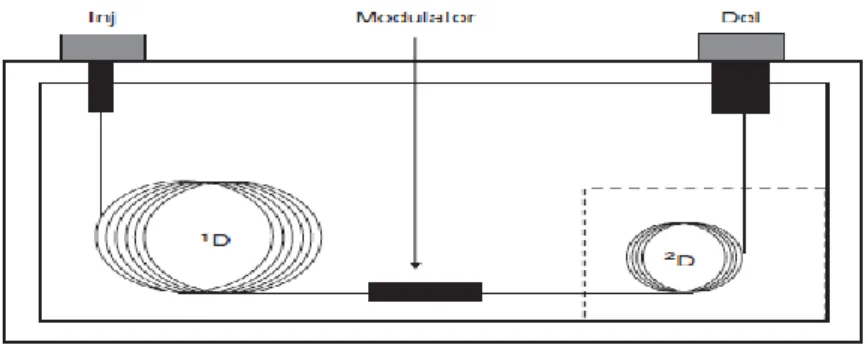Screening for Putative Biomarkers of Lung Cancer in
Exhaled Air
R. Pesesse1, P.-H. Stefanuto1, F. Schleich2, R. Louis2, J.-F. Focant1
1
Organic and Biological Analytical Chemistry, CART, Chemistry Department, University of Liège, Belgium
2
Pneumology and Allergology Unit, University Hospital Center, Liège, Belgium
Introduction
Early stage non-invasive diagnostic of diseases can possibly take place by analyzing volatile organic compounds (VOCs) released from the breath of patients [1]. Lung cancer is typically silent early in its course, so that a majority of patients are diagnosed at an advanced stage, resulting in poor prognosis [2]. The implementation of an early diagnostic procedure for lung cancer screening by means of breath analysis could possibly contribute to increase the survival rate of diagnosed patients.
Analytical Strategy
Exhaled breath samples are collect from patients and healthy controls using inert bags (Tedlar® bags) of 5 liters at the University Hospital Center of Liège at the time of bronchoscopy. These bags are later emptied on sorbent tubes (Carbopack® and Tenax®) for controlled storage of the VOCs, and sent to the analytical chemistry laboratory of the Liège University for analyses. Typically, breath VOC samples are analyzed using one dimensional (single-column) gas chromatography coupled to mass spectrometry (1DGC-MS). In that context, a limited number (< 50) of VOCs (mainly alkane and benzene derivatives) has been identified as potential biomarkers of disease in breath VOC profile [3].
Because of the complexity of breath VOC mixtures, it is believed that more biomarker candidate could be found. Comprehensive two-dimensional GC coupled to time-of-flight mass spectrometry (GC×GC-TOFMS) is a powerful separation science tool and has been successfully used to separate more than one thousand of VOCs in human breath (Figure 1) [4].
FIGURE 1 Schematic representation of GC×GC system. Two chromatographic columns are
In addition to the large peak capacity, latest advances in GC×GC-TOFMS data processing tools also allow better handling of interfering environmental VOCs to the breath signature. Supervised statistics can be applied to complex GC×GC chromatograms in either a peak table-based or a pixel-based approach [5,6]. A Fisher discriminant ratio method is used to investigate data sets and highlighted peaks are specifically processed using classical principal component analysis (PCA). Such an advanced data processing allows inter-individual variations and sampling effects be minimized in order to enhance the isolation of candidate specific molecules (Figure 2).
FIGURE 2 PCA of samples from exalted breath of patients at 3 different sampling periods to
show the impact of interfering environmental VOCs.
Conclusion
In this paper, we report on practical examples of such specific data treatment procedures for temptative biomarker isolation and identification. GC×GC-high resolution (HR) TOFMS is also used for molecular formula determination (e.g. final identification of biomarkers) as the ultimate step for unequivocal detection of biomarkers from exhaled breath.
References
[1] L.Pauling, A.Robinson, R.Teranishi and P.Cary. Quantitative Analysis of Urine Vapor and Breath by Gas-Liquid Partition Chromatography. Proc Nat Acad Sci USA, 1971. 68(10): p. 2374-2376.
[2] J.Mazzone. Analysis of Volatile Organic Compounds in the Exhaled Breath for the Diagnosis of Lung Cancer. Journal of Thoracic Oncology, 2008. 3(7)
[3] H.Chan, C.Lewis and P.Thomas. Exhaled Breath Analysis: Novel Approach for Early Detection of Lung Cancer. Lung Cancer, 2009. 63: p. 164-168
[4] M.Phillips, R.Cataneo, A.Chaturvedi, P.Kaplan, M.Libardoni et al. Detection of an Extended Human Volatome with Comprehensive Two Dimensional Gas Chromatography Time-of-Flight Mass Spectrometry. Plos One, 2013. 8(9): e75274.
[5] P.-H.Stefanuto, K.Perrault, S.Stadler, R.Pesesse, M.Brokl et al. Reading Cadaveric Decomposition Chemistry With a New Pair of Glasses. ChemPlusChem, 2014. 79(6): p. 786-789
[6] P.-H.Stefanuto, K.Perrault, R.Lloyd, B.Stuart, T.Rai et al. Exploring New Dimensions in Cadaveric Decomposition Odour Analysis. Anal. Methods, 2015. 7: p. 2287-2294

